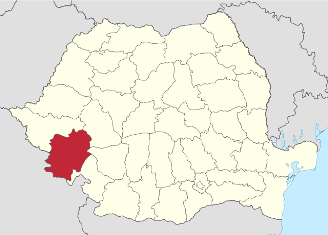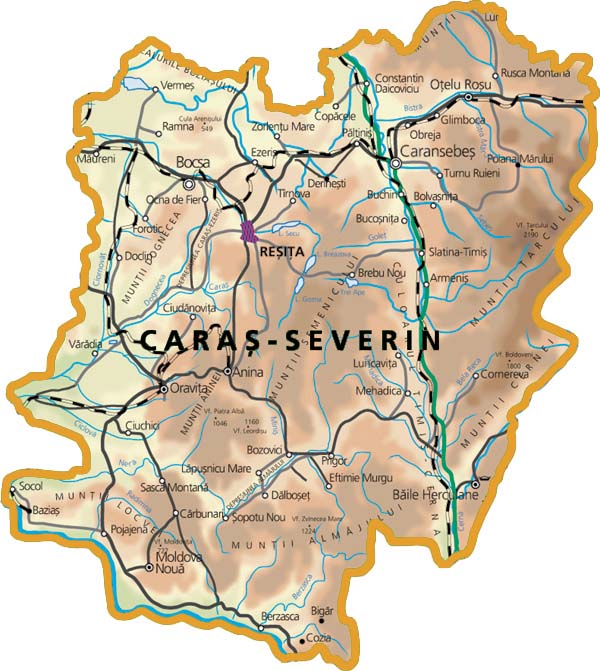Caraş-Severin Judet (Romanian) – Krassó-Szörény Megye (Hungarian) – Karaš-Severin (Serbian)
South Western Romania – Eastern Banat


The official name is Caras-Severin Judet [Krassó-Szörény Megye (Hungarian)], a county of southwestern Romania, in the historical region Banat, with the county seat at Reşiţa.
Situated on the Danube left-side, between the Southern Carpathians and the south part of the Western Carpathians. It is bounded on the south and west by Serbia. With 8,514 km2, it is the third largest county in Romania, after Timis and Suceava counties. It is also the county through which the Danube River enters Romania.
Habsburg Monarchy of Austria, in its province named Banat. The county seat, Reşiţa, was founded in 1771 and became a modern industrial center during the Austrian occupation. The area received considerable attention due to its mines industry. In 1855, the entire Banat area, with its supplies of mineral deposits and timber, was transferred from the Austrian Treasury to an Austrian and French mining and railroad company named StEG. StEG built the Oraviţa-Baziaş line—Romania’s oldest railroad track.
Caraş-Severin County has 2 municipalities: Caransebeș & Reşiţa; 6 towns: (Anina,
Băile Herculane, Bocşa, Moldova Nouă, Oraviţa, Oţelu Roşu and 69 villages:
Caransebeș Municipality
Karansebesch (German)
Karánsebes (Hungarian)
Karanšebeš (Serbian, Kroatien)
Caransebeș, Romania (Official)
Facts & Finds
Caransebeș is a city located at the junction of the two rivers Timiș and Sebeș, the latter coming from the Țarcu Mountains. To the west, it is in direct contact with the Banat Hills. It is an important railroad node, being located approximately 40 km away from Reșița, 21 km from Oțelu Roșu, 70 km from Hațeg and about 25 km from the Muntele Mic ski resort, in the Țarcu Mountains.
1872 Caransebes became a town.
Caransebes was of strategic importance on the former Austrian military frontier.
Karansebesch (Josephinische Landaufnahme)
Anuarul “Socec”al României-mari Library of Congress Online Catalog
Caras-Severin Judet, Romanian (Img 1269) Start of Village Information (Img 1281)
One village is administered by the city: Jupa (Hungarian: Zsuppa)
Juppa (German)
Schuppa (Josephinische Landaufnahme)
Zsuppa (Hungarian)
Jupa, Romania (Official)
Konstantin Kapra was knighted on 08/23/1821, receiving donation Jupa town in the county of Caras, proclaiming the noble title in the county on 15/07/1822. The settlement remained and still family owned.
The marriage of Stephanos Manos to Katerina Kapra, a lady of noble lineage, proved to be a decisive event for the family’s social mobility and the consolidation of its capital wealth. The latter was the daughter of Konstantinos Kapra, who belonged to the Hungarian aristocracy and came from Moschopoli. The social status of the family, its economic power and its Aromonian origins were probably key factors which influenced the decision of Stephanos to create bonds of kinship with the Moschopolian family. Thus he managed to rise quickly within the social hierarchy of Hungary, while his marriage enabled him to increase his personal fortune. The dowry received by Katerina Kapra after her marriage to Stephanos consisted of a landed property of 1,000 holds in Zsuppa, a fertile region of Hungary. It was undoubtedly an important means of strengthening the economic and social capital of the Manos family. 87: The family Kapra owned the estate of Zsuppa (today Jupa) just to the north of the Romanian town of Caransebes. See Peyfuss, “Aromanian Landlords in the Banat around 1800′, pp 59-82, in particular p.74. (Commerce and Culture: Nineteenth-Century Business Elites, Professor Robert Lee Ashgate Publishing, Ltd., Jul 28, 2013 – 368 pages)
Reşiţa Municipality
Reschitz (German)
Resicabánya (Hungarian)
Ričica (Croatian)
Rešice (Czech)
Решица/Rešica, (Serbian)
Reșița, Romania (Official)
Facts & Finds
A city in western Romania and the capital of Caraș-Severin County, in the Banat region. Its 2004 population was 83,985. – capital city; population: 86,383 (2006)
The town was referenced to in the conscription acts of 1717 under the name of Retziza.
On 3 July 1771, it became an important metal-manufacturing center in the region. The foundation of the industrial Reșița were laid with the establishment of factories near the villages of Reșița Română (Reschiza Kamerală or Oláh Resitza) and Reșița Montană (Eisenwerk Reschitza, Német(h) Reschitza or Resiczbánya).
Reșița Montană was at first inhabited by Romanians, and later, in 1776, 70 German families settled there.
Between 1880 and 1941, Germans were the dominant population in the city, with as many of them as 12,096 residing here in 1941, as opposed to 9,453 Romanians, and 1861 Hungarians living here in the same year.
Between the years 1910–1925, Reșița had the status of a rural area, and in 1925, it was declared a town thanks to its development to a powerful industrial location in modern Romania. In 1968, it became a municipality. After 1989 Reșița lost most of its importance and its economy faced a drawback, along with the Romanian economy.
2 MUNICIPALITIES
Caransebeș
Reşiţa
6 TOWNS
Anina
Băile Herculane
Bocşa
Moldova Nouă
Oraviţa (Admin. for Agaditsch)
Oţelu Roşu (Admin. for Almafa)
2 VILLAGES
Agaditsch
Mal
68 COMMUNES
- Armeniş
- Almafa
- Bănia
- Băuţar
- Berlişte
- Berzasca
- Berzovia
- Bolvaşniţa
- Bozovici
- Brebu
- Brebu Nou
- Buchin
- Bucoşniţa
- Caraşova
- Cărbunari
- Ciclova Română
- Ciuchici
- Ciudanoviţa
- Constantin Daicoviciu
- Copăcele
- Cornea
- Cornereva
- Coronini
- Dalboşeţ
- Doclin Dognecea
- Domaşnea
- Eftimie Murgu
- Ezeriş
- Fârliug
- Forotic
- Gârnic
- Glimboca
- Goruia
- Grădinari
- Iablaniţa
- Lăpuşnicel
- Lăpuşnicu Mare
- Luncaviţa
- Lupac
- Marga
- Măureni
- Mehadia
- Mehadica
- Naidăş
- Obreja
- Ocna de Fier
- Păltiniş
- Pojejena Prigor
- Răcăşdia
- Ramna
- Rusca Montană
- Sacu
- Sasca Montană
- Sicheviţa
- Slatina-Timiş
- Socol
- Şopotu Nou
- Târnova
- Teregova
- Ticvaniu Mare
- Topleţ
- Turnu Ruieni
- Văliug
- Vărădia
- Vermeş
- Vrani (Alsóvarány)
- Zăvoi
- Zorlenţu Mare
- Das Banater Bergland
Anina -Steierdorf
Bokschan
Eisenstein
Ferdinandsberg
Franzdorf
Herkulesbad
Königsgnad/Tirol
Neumoldowa
Orawitz
Orschowa
Reschitz
Russberg
Saska
Sekul
Tschiklowa- © Banater Berglanddeutsche
Villages with Little or No information
Villages located in Caras-Severin for which little or no information is available are show below. The list is arranged alphabetically by the German or best known village name. Other names for those villages are show as well as any small amount of information.
- Alsóvarány (Hungarian) – Vrány (Hungarian) – Vraniu (Romanian) – Varani (Romanian) – Vrani, Romania (Official) – West of Oravita
- Bánya (Hungarian) – Bănia, Romania (Official) – Composed of Bănia and Gârbovăţ villages.
- Barbotza (German) – Barbos (Hungarian) – Bărbosu, Romania (Official)
- Bersing (German) – Bersa (German) – Börzsény (Hungarian) – Börsza (Hungarian) – Bârza (Other) – Börza (Hungarian) – Bîrza, Romania (Official) – 8 km South from Herkulesbad
- Binisch (German) – Bényes (Hungarian) – Binis, Romania (Official) – Binisch – Das Banat in: Josephinische Landesaufnahme, 1769-72
- Bisztracseres (Hungarian) – Cseresbisztra (Hungarian) – Csirésa (Hungarian) – Cserese Pistra (Romania) – Cireşa, Romania (Official) – Cserese Pistra – Das Banat in: Josephinische Landesaufnahme, 1769-72
- Bolvasnica (Hungarian) – Bolvás (Hungarian) – Alsóbolvasnica (Hungarian) – Felsőbolvasnica (Hungarian) – Polvaschniza (Josephinische) – Bolvaşniţa, Romania (Official) — Polvaschniza – Josephinische Landesaufnahme, 1769-72
- Fényes (Hungarian) – Fenes, Romania (Official)
- Ferdinandsberg (German) – Nandorhegy (Hungarian) – Ferdinand (Other) – Otelu Rosu, Romania (Official)
- Fisesch (German) – Krassófüzes (Hungarian) – Fizeș, Romania (Official)
- Forotik (Hungarian) – Forotic, Romania (Official)
- Franzdorf (German) – Ferencfalva (Hungarian) – Văliug, Romania (Official) – Genealogical Records – Church records available at LDS – FHC Microfilm Nr. : 029 RO – Franzdorf B 1793-1852 M 1793-1855 D 1793-1856
- Furlug (German) – Furlak (Hungarian) – Fîrliug, Romania (Official) – Commune composed of six villages: Dezești, Duleu, Fârliug, Remetea-Pogănici, Scăiuș and Valea Mare.
- Galacs (Hungarian) – Golet, Romania (Official)
- Geröcz (Hungarian) – Greoni, Romania (Official)
- Gertenisch (German) – Gertenyes (Hungarian) – Ghertenis, Romania (Official)
- Gladova (German) – Bégakalodva (Hungarian) – Kalodva (Hungarian) – Kládova (Hungarian) – Cladova, Romania (Official) — Gladova (German) Das Banat in: Josephinische Landesaufnahme, 1769-72 (Österreichisches Staatsarchiv, Kriegsarchiv)
- Golbor (Hungarian) – Globurãu, Romania (Official)
- Gornyareva (Hungarian) – Somosréve (Hungarian) – Cornereva, Romania (Official)
- Großsurduk (German) – Gross Surduk (German) – Nagyszurduk (Hungarian) – Surducu Mare, Romania (Official)
- Heuerdorf (German) – Heyerdorf (German) – Hévér (Hungarian) – Hauerdorf (Other) – Iertof, Romania (Official) — Genealogical Records – Church records available at LDS – FHC Microfilm Nr. : 047 RO – Heuerdorf B 1732-1838 M 1732-1838 D 1732-1838
- Kakova (German) – Kakowa (German) – Kakofalva (Hungarian) – Grădinari, Romania (Official)
- Kallina (German) – Galonya (Hungarian) – Calina, Romania (Official)
- Kavarán (Hungarian) – Căvăran, Romania (Official) — Part of the Constantin Daicoviciu commune, villages include:, Maciova, Mâtnicu Mare, Peștere, Prisaca and Zăgujeni
- Kernyécsa (Hungarian) – Cîrnecea, Romania (Official)
- Kismiháld (Hungarian) – Mehadica, Romania (Official)
- Kölnök / Kolnok (Hungarian) – Câlnic, Romania
- Kornya (Hungarian) – Somfa (Hungarian) – Cornea, Romania
- Körpa (Hungarian) – Valea Timisului, Romania
- Krassószekas (Hungarian) – Szekas (Hungarian) – Secășeni, Romania (Official)
- Macsova (Hungarian) – Maciova, Romania
- Majdan (Hungarian) – Brãdisorul de Jos, Romania
- Marga (Hungarian) – Marga, Romania
- Mehadia (German) – Mehadia (Hungarian) – Mehadia, Romania
- Mercsény / Mercseny (Hungarian) – Merczina (Hungarian) – Mercina, Romania
- Nagylangás (Hungarian) – Nagylankás (Hungarian) – Luncavita, Romania
- Nagytikvány (Hungarian) – Ticvanul Mare, Romania
- Najdas (Hungarian) – Naidäs / Naidas, Romania
- Nérapatas (Hungarian) – Pãtas, Romania
- Obrescha (German) – Bisztere (Hungarian) – Obreja, Romania
- Petnik (German) – Petnek (Hungarian) – Petnic, Romania
- Petresfalva (Hungarian) – Petrosnita, Romania
- Pogodintz (German) Bogorfalva – (Hungarian) – Bogodint, Romania
- Pozsgás (Hungarian) – Pozsezsena – (Hungarian) – Pojejena, Romania
- Prigor, Romania
- Prilipetz (German) – Prilipet, Romania
- Rakasd (Hungarian) – Rãcãsdia, Romania
- Rakito (Hungarian) – Rãchitova, Romania
- Rafna (Hungarian) – Ramna, Romania
- Rebenberg (German) Szölöhegy (Hungarian)
- Remete (Hungarian) – Pogányosremete (Hungarian) – Remetea-Pogãnici, Romania
- Reschitza (German) – Resicabánya (Hungarian) – Reschitz (Other) – Resita, Romania
- Rumänisch-Bokschan (German) – Várboksán (Hungarian) – Bocsa Românã, Romania
- Szakalár (Hungarian) – Socolari, Romania
- Szócsán (Hungarian) – Soceni, Romania
- Szörénybalázsd (Hungarian) – Voislova, Romania
- Tautz (German) – Feltót (Hungarian) – Taucz (Hungarian) Tauti, Romania
- Teregowa (German) – Teregova (Hungarian) – Teregova, Romania
